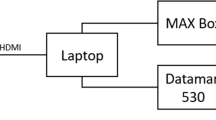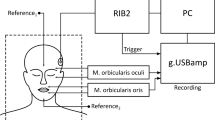Abstract
Purpose
Electrocochleography (ECochG) measures electrical potentials generated by the inner ear in response to acoustic stimulation. Real-time (rt) recordings are increasingly used during cochlear implant (CI) surgeries to monitor the inner ear function. However, the performance of rt-ECochG is a delicate measurement procedure involving several pitfalls, which lead to inaccurate or invalid signal recordings in up to 20%. In order to use the technique routinely in CI candidates, an improvement in measurement reliability must be achieved.
Methods
In our prospective study, we systematically investigated potential pitfalls and error sources during rt-ECochG recordings. We performed experiments (i) on a head and torso simulator, (ii) on a whole-head cadaver specimen, (iii) as well as in vivo during rt-ECochG recordings in CI recipients. After analyzing experiments i–iii, a standardized measurement procedure was developed. We followed this guideline in 10 CI recipients to test the measurement reliability.
Results
Besides improper installation, surgical and patient-specific factors influenced the measured signal. In particular, the unattenuated presentation of the acoustic stimulus was of importance. We summarized our findings in a standardized guideline. Following this guideline, we measured successful intraoperative ECochG recordings in 9/10 patients.
Conclusions
Our error analysis improved the understanding of successful rt-ECochG measurements. When following our proposed guideline, we achieved more reliable intraoperative ECochG recordings.





Similar content being viewed by others
Availability of data and material
Is made available on request.
Code availability
Not applicable.
References
Helbig S, Adel Y, Rader T, Stöver T, Baumann U (2016) Long-term hearing preservation outcomes after cochlear implantation for electric-acoustic stimulation. Otol Neurotol 37(9):e353–e359. https://doi.org/10.1097/MAO.0000000000001066
O’Connell BP, Hunter JB, Haynes DS, Holder JT, Dedmon MM, Noble JH, Wanna GB (2017) Insertion depth impacts speech perception and hearing preservation for lateral wall electrodes. The Laryngoscope 127(10):2352–2357. https://doi.org/10.1002/lary.26467
Sprinzl GM, Schoerg P, Edlinger SH, Magele A (2020) Long-term hearing preservation in electric acoustic cochlear implant candidates. Otol Neurotol 41(6):750–757. https://doi.org/10.1097/MAO.0000000000002627
Mertens G, Punte AK, Cochet E, De Bodt M, Van de Heyning P (2014) Long-term follow-up of hearing preservation in electric-acoustic stimulation patients. Otol & Neurotol 35(10):1765–1772. https://doi.org/10.1097/MAO.0000000000000538
Snels C, Inthout J, Mylanus E, Huinck W, Dhooge I (2019) Hearing preservation in cochlear implant surgery: a meta-analysis. Otol Neurotol 40(2):145–153. https://doi.org/10.1097/MAO.0000000000002083
Friedland DR, Runge-Samuelson C (2009) Soft cochlear implantation: rationale for the surgical approach. Trends Amplif 13(2):124–138. https://doi.org/10.1177/1084713809336422
Thompson NJ, Dillon MT, Buss E, Park LR, Pillsbury HC III, O’Connell BP, Brown KD (2020) Electrode array type and its impact on impedance fluctuations and loss of residual hearing in cochlear implantation. Otol Neurotol 41(2):186–191. https://doi.org/10.1097/MAO.0000000000002457
Bester C, Razmovski T, Collins A, Mejia O, Foghsgaard S, Mitchell-Innes A, O’Leary S (2020a) Four-point impedance as a biomarker for bleeding during cochlear implantation. Sci Rep 10(1):1–12. https://doi.org/10.1038/s41598-019-56253-w
Shaul C, Weder S, Tari S, Gerard JM, O’Leary SJ, Briggs RJ (2020) Slim, modiolar cochlear implant electrode: melbourne experience and comparison with the contour perimodiolar electrode. Otol Neurotol 41(5):639–643. https://doi.org/10.1097/MAO.0000000000002617
Rajan G, Tavora-Vieira D, Baumgartner WD, Godey B, Müller J, O’Driscoll M, Van de Heyning P (2018) Hearing preservation cochlear implantation in children: the HEARRING Group consensus and practice guide. Coch Implants Int 19(1):1–13. https://doi.org/10.1080/14670100.2017.1379933
Ruben RJ, Bordley JE, Lieberman AT (1961) Cochlear potentials in man. The Laryngoscope 71(10):1141–1164. https://doi.org/10.1288/00005537-196110000-00001
Campbell L, Kaicer A, Sly D, Iseli C, Wei B, Briggs R, O’Leary S (2016) Intraoperative real-time cochlear response telemetry predicts hearing preservation in cochlear implantation. Otol Neurotol 37(4):332–338. https://doi.org/10.1097/MAO.0000000000000972
Dalbert A, Pfiffner F, Hoesli M, Koka K, Veraguth D, Roosli C, Huber A (2018) Assessment of cochlear function during cochlear implantation by extra-and intracochlear electrocochleography. Frontiers in neuroscience 12:18. https://doi.org/10.3389/fnins.2018.00018
Weder S, Bester C, Collins A, Shaul C, Briggs RJ, O’Leary S (2020) Toward a better understanding of electrocochleography: analysis of real-time recordings. Ear Hear 41(6):1560–1567. https://doi.org/10.1097/AUD.0000000000000871
Weder S, Bester C, Collins A, Shaul C, Briggs RJ, O’Leary S (2021) Real time monitoring during cochlear implantation: increasing the accuracy of predicting residual hearing outcomes. Otol Neurotol. https://doi.org/10.1097/MAO.0000000000003177
Yin LX, Barnes JH, Saoji AA, Carlson ML (2021) Clinical Utility of Intraoperative Electrocochleography (ECochG) During Cochlear Implantation: a Systematic Review and Quantitative Analysis. Otology & Neurotology 42(3):363–371. https://doi.org/10.1097/MAO.0000000000002996
Giardina CK, Brown KD, Adunka OF, Buchman CA, Hutson KA, Pillsbury HC, Fitzpatrick DC (2019) Intracochlear electrocochleography: response patterns during cochlear implantation and hearing preservation. Ear Hear 40(4):833. https://doi.org/10.1097/AUD.0000000000000659
Maftoon N, Funnell WRJ, Daniel SJ, Decraemer WF (2014) Effect of opening middle-ear cavity on vibrations of gerbil tympanic membrane. JARO 15(3):319–334. https://doi.org/10.1007/s10162-014-0442-3
Campbell L, Kaicer A, Sly D, Iseli C, Wei B, Briggs R, O’Leary S (2016) Intraoperative real-time cochlear response telemetry predicts hearing preservation in cochlear implantation. Otol Neurotol 37(4):332–338. https://doi.org/10.1097/MAO.0000000000000972
Wagner F, Wimmer W, Leidolt L, Vischer M, Weder S, Wiest R, Caversaccio MD (2015) Significant artifact reduction at 1.5 T and 3T MRI by the use of a cochlear implant with removable magnet: an experimental human cadaver study. PLoS One 10(7):e0132483. https://doi.org/10.1371/journal.pone.0132483
Bester C, Weder S, Collins A, Dragovic A, Brody K, Hampson A, O’Leary S (2020b) Cochlear microphonic latency predicts outer hair cell function in animal models and clinical populations. Hear Res 398:108094. https://doi.org/10.1016/j.heares.2020.108094
Dalbert A, Sijgers L, Grosse J, Veraguth D, Roosli C, Huber A, Pfiffner F (2020) Simultaneous Intra- and Extracochlear Electrocochleography During Electrode Insertion. Ear Hear 42(2):414–424
O’Leary S, Briggs RJ, Gerard J-MM et al (2020) Intraoperative observational real-time electrocochleography as a predictor of hearing loss after cochlear implantation: 3 and 12 month outcomes. Hear Res 41(9):1222–1229
Ramos-Macias A, O’Leary S, Ramos-deMiguel A, Bester C, Falcon-González JC (2019) Intraoperative intracochlear electrocochleography and residual hearing preservation outcomes when using two types of slim electrode arrays in cochlear implantation. Otol Neurotol 40(5S):S29–S37. https://doi.org/10.1097/MAO.0000000000002212
Acknowledgements
The authors would like to thank Marek Polak and his team from MED-EL, Austria, for their support.
Funding
This study was partly funded by the Department of Otorhinolaryngology, Head and Neck Surgery at the Inselspital Bern, the Clinical trials unit (CTU) research grant, and the MED-EL company. Georgios Mantokoudis was supported by the Swiss National Science Foundation #320030_173081.
Author information
Authors and Affiliations
Contributions
All authors contributed to this work. KS performed the experiments, wrote the software and paper. MW performed the experiments and wrote the paper. GM, LA, and MC provided interpretive analysis and critical revision. WW analyzed the data and provided interpretive analysis and critical revision. SW designed the experiment, analyzed the data, and provided interpretive analysis and critical revision.
Corresponding author
Ethics declarations
Conflict of interest
There are no conflicts of interest, financial, or otherwise.
Ethics approval
This experimental study was conducted in accordance with the Declaration of Helsinki and was approved by the local institutional review board (KEK-BE 2016–00887 and 2019–01578).
Consent to participate
All participants gave written informed consent before participating in the study.
Consent for publication
Not applicable.
Additional information
Publisher's Note
Springer Nature remains neutral with regard to jurisdictional claims in published maps and institutional affiliations.
Supplementary Information
Below is the link to the electronic supplementary material.
Rights and permissions
About this article
Cite this article
Schuerch, K., Waser, M., Mantokoudis, G. et al. Increasing the reliability of real-time electrocochleography during cochlear implantation: a standardized guideline. Eur Arch Otorhinolaryngol 279, 4655–4665 (2022). https://doi.org/10.1007/s00405-021-07204-7
Received:
Accepted:
Published:
Issue Date:
DOI: https://doi.org/10.1007/s00405-021-07204-7




